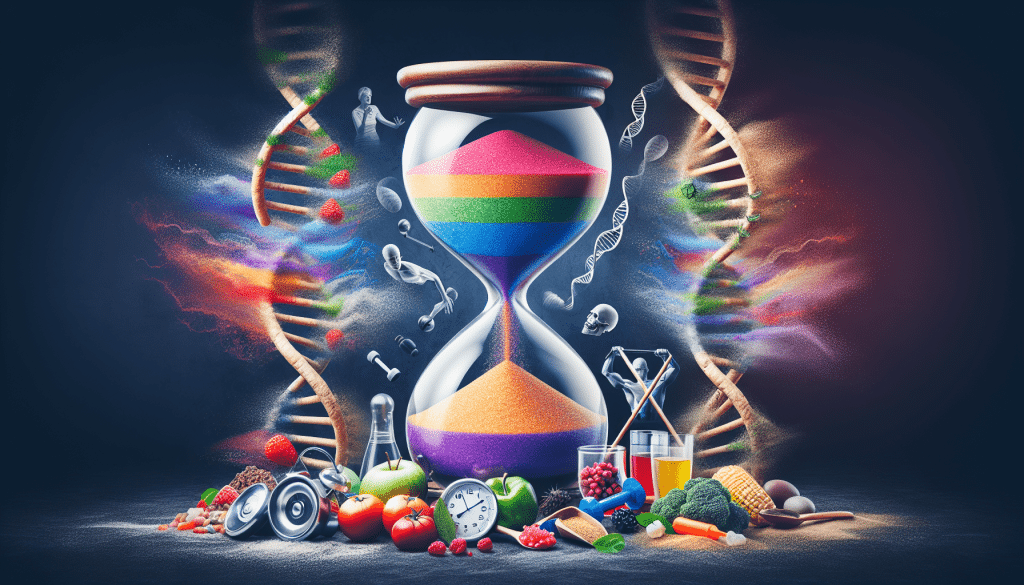Are you curious about the fascinating process of aging? This article will take you on an enlightening journey, exploring the captivating science behind the aging process. From the intricate workings of our cells to the influence of genetics and lifestyle choices, we will unravel the mysteries behind why we age and how it affects our bodies. Join us as we unravel the secrets hidden within the passage of time and gain a deeper understanding of the remarkable phenomenon that is aging.

1. What is aging?
Aging is a natural and inevitable process that every living organism experiences over time. It refers to the progressive deterioration of biological functions and structures, resulting in a decline in overall health and an increased vulnerability to diseases and death. While aging is a universal phenomenon, the rate at which it occurs can vary among individuals. Understanding the causes and mechanisms behind aging is crucial for promoting healthy aging and developing interventions to extend lifespan.
1.1 Definition of aging
Aging can be defined as the accumulation of changes in an organism over time, including physiological, cellular, and molecular alterations that occur as a result of the passage of time. These changes can be observed at various levels, from cellular processes to the overall functioning of organ systems, and can impact both physical and cognitive health.
1.2 Causes of aging
The process of aging is influenced by various factors, including both genetic and environmental components. Genetic factors play a significant role in determining the maximum lifespan and the rate of aging. Environmental factors such as lifestyle choices, exposure to toxins, and the presence of chronic diseases can also accelerate the aging process.
2. The biology of aging
Understanding the biology of aging is essential for unraveling the mechanisms underlying this complex process. Several key aspects contribute to aging, including cellular aging, genetic factors, and the role of telomeres.
2.1 Cellular aging
Cellular aging refers to the gradual decline in the functionality and efficiency of cells as they age. Over time, cells accumulate damage and lose their ability to repair themselves, leading to a decline in organ function. This cellular decline is a fundamental aspect of the aging process.
2.2 Genetic factors
Genetic factors play a significant role in determining the rate of aging and lifespan. Researchers have identified certain genes, known as “longevity genes,” that are associated with enhanced longevity. These genes are involved in various cellular processes, including DNA repair, oxidative stress response, and cellular metabolism.
2.3 Telomeres and aging
Telomeres are protective structures located at the ends of chromosomes. They shorten with each cell division, serving as a molecular clock that tracks cellular aging. As telomeres become critically short, cells enter a state of senescence or undergo apoptosis, contributing to the overall aging process. Telomere length and maintenance are thus critical factors in determining cellular lifespan.
3. The impact of lifestyle on aging
While genetic factors play a role in aging, lifestyle choices also significantly impact the aging process. Several key aspects of lifestyle, including diet, exercise, and sleep, can have a profound influence on the rate at which an individual ages.
3.1 Diet and aging
A balanced and nutritious diet is crucial for healthy aging. Consuming a variety of fruits, vegetables, whole grains, lean proteins, and healthy fats provides essential nutrients, antioxidants, and anti-inflammatory compounds that support cellular health. On the other hand, a diet high in processed foods, sugars, and unhealthy fats can contribute to oxidative stress, inflammation, and accelerated aging.
3.2 Exercise and aging
Regular physical activity has been shown to have numerous benefits for aging individuals. Exercise not only helps maintain physical strength, endurance, and flexibility but also enhances cardiovascular health, stimulates the production of growth factors, and improves cognitive function. Engaging in activities such as aerobic exercise, strength training, and flexibility exercises can contribute to healthy aging.
3.3 Sleep and aging
Adequate sleep is vital for overall health and well-being, including healthy aging. During sleep, the body undergoes essential restorative processes, including cellular repair and memory consolidation. Chronic sleep deprivation and poor sleep quality have been associated with increased inflammation, oxidative stress, cognitive decline, and an increased risk of age-related diseases. Prioritizing good sleep hygiene is crucial for promoting healthy aging.
4. The role of oxidative stress in aging
Oxidative stress is a key factor in the aging process and occurs when there is an imbalance between the production of reactive oxygen species (ROS) and the body’s ability to neutralize them. In healthy individuals, the body has natural antioxidant defense mechanisms to counteract oxidative stress. However, as we age, these defense mechanisms weaken, leading to accumulated damage and accelerated aging.
4.1 What is oxidative stress?
Oxidative stress occurs when there is an excess production of ROS, such as free radicals, in the body. ROS are highly reactive molecules that can damage cellular structures, including DNA, proteins, and lipids. Oxidative stress can result from various factors, including exposure to toxins, poor diet, inflammation, and chronic diseases.
4.2 Oxidative stress and aging
The accumulation of oxidative damage over time contributes to the aging process. Oxidative stress can lead to cellular dysfunction, impaired metabolism, chronic inflammation, and an increased susceptibility to age-related diseases. It is essential to manage oxidative stress through lifestyle choices and antioxidant-rich diets to promote healthy aging.
4.3 Antioxidants and aging
Antioxidants are compounds that neutralize ROS and protect cells from oxidative damage. Consuming a diet rich in antioxidants, including vitamins A, C, and E, as well as phytochemicals found in fruits, vegetables, and whole grains, can help mitigate oxidative stress and promote healthy aging. Additionally, lifestyle choices such as avoiding exposure to toxins, quitting smoking, and managing stress levels can also contribute to reducing oxidative stress.

5. Inflammation and aging
Chronic inflammation is a common characteristic of the aging process and is associated with the development of various age-related diseases. Understanding the role of inflammation in aging and implementing strategies to control it is crucial for healthy aging.
5.1 Chronic inflammation
Chronic inflammation is a persistent low-grade inflammatory state that occurs when the immune system is constantly activated, leading to the release of inflammatory molecules. It can stem from various factors, including chronic infections, obesity, unhealthy diet, and sedentary lifestyle. Chronic inflammation can contribute to tissue damage, impaired cellular function, and the development of age-related diseases.
5.2 Inflammatory diseases and aging
Age-related diseases, such as cardiovascular diseases, neurodegenerative diseases, and cancer, often involve chronic inflammation as a contributing factor. Inflammation can lead to endothelial dysfunction, neuronal damage, and DNA mutations, promoting the development and progression of these diseases. Managing inflammation through lifestyle choices, including a healthy diet, regular exercise, and stress reduction techniques, can help mitigate the risk of age-related diseases.
5.3 Controlling inflammation for healthy aging
Several lifestyle interventions can help control inflammation and promote healthy aging. Consuming an anti-inflammatory diet rich in fruits, vegetables, whole grains, and healthy fats can provide essential nutrients and anti-inflammatory compounds. Regular exercise, adequate sleep, stress management techniques such as meditation or yoga, and avoiding tobacco and excessive alcohol consumption can also help regulate inflammation and support healthy aging.
6. The role of hormones in aging
Hormones play a critical role in regulating various physiological processes in the body, and their levels and balance can change with age. Hormonal changes can contribute to the aging process and the development of age-related diseases.
6.1 Hormonal changes with age
As individuals age, the production and regulation of hormones decline or become imbalanced. Hormonal changes can affect metabolic function, cardiovascular health, bone density, cognitive function, and overall well-being. Common hormonal changes in aging include declining levels of estrogen and testosterone, as well as changes in thyroid and growth hormone levels.
6.2 Hormones and aging-related diseases
Imbalances in hormonal levels can contribute to the development of age-related diseases. For example, declining estrogen levels in menopause can lead to increased risk of osteoporosis and cardiovascular diseases, while imbalances in thyroid hormones can affect metabolism and brain function. Understanding these hormone-related changes and seeking medical guidance for hormone replacement therapy or other interventions can help manage age-related symptoms and promote healthy aging.

7. Age-related diseases
Aging is a risk factor for various diseases, and the incidence of age-related diseases tends to increase with advancing age. These diseases can significantly impact an individual’s quality of life and overall health.
7.1 Cardiovascular diseases
Cardiovascular diseases, including heart disease, stroke, and hypertension, are common age-related conditions. The risk of developing these diseases increases with age due to factors such as arterial stiffness, high blood pressure, and atherosclerosis. Adopting a heart-healthy lifestyle, including regular exercise, a balanced diet, managing stress, and regular medical check-ups, can reduce the risk of cardiovascular diseases and promote healthy aging.
7.2 Neurodegenerative diseases
Neurodegenerative diseases, such as Alzheimer’s disease and Parkinson’s disease, are characterized by the progressive loss of neurons and impaired neurological function. The risk of developing these diseases increases with age, and they can have a significant impact on cognitive function and overall well-being. Although no cure currently exists, engaging in mentally stimulating activities, maintaining a healthy lifestyle, and seeking early medical intervention can help manage symptoms and improve quality of life.
7.3 Cancer
Cancer is another age-related disease that increases in incidence with advancing age. Mutations in DNA accumulate over time, leading to uncontrolled cell growth and tumor formation. Adopting a healthy lifestyle, including a balanced diet, regular exercise, avoiding tobacco and excessive alcohol consumption, and regular cancer screenings, can help reduce the risk of developing cancer and improve prognosis.
8. The science of longevity
Researchers are continuously exploring the factors and mechanisms that contribute to longevity and the potential interventions that can extend healthy lifespan. Genetic factors, caloric restriction, and anti-aging interventions are all areas of active research in the field of longevity.
8.1 Genetic factors influencing lifespan
Genetic factors play a significant role in determining an individual’s lifespan and the rate of aging. Researchers have identified specific genes and genetic variations that can impact longevity. For example, certain gene variants involved in DNA repair, oxidative stress response, or cellular metabolism have been associated with enhanced longevity. Genetic studies continue to shed light on the complex interplay of genes and aging processes.
8.2 Caloric restriction and longevity
Caloric restriction, or reducing calorie intake without malnutrition, has been shown to extend lifespan and improve health span in various organisms, including yeast, worms, flies, and rodents. Caloric restriction triggers metabolic and cellular adaptations that enhance cellular function, delay age-related diseases, and prolong lifespan. Investigating the underlying mechanisms of caloric restriction may provide valuable insights into the biology of aging.
8.3 Anti-aging interventions
Several interventions are being explored for their potential anti-aging effects. These include the use of pharmaceutical compounds, such as rapamycin and metformin, that target specific cellular pathways involved in aging. Other approaches include senolytics, which selectively eliminate senescent cells, and stem cell therapies, which aim to regenerate damaged tissues. While the development of effective anti-aging interventions is still ongoing, these areas of research show promise for extending healthy lifespan and improving overall aging outcomes.

9. The future of aging research
Aging research is a rapidly evolving field, and scientists are continually making new discoveries and advances in understanding the complexities of the aging process. Some of the key areas of focus in aging research include genetic and epigenetic factors, novel interventions, and the development of biomarkers for monitoring aging-related changes and the effectiveness of interventions.
9.1 Advances in aging research
Advances in technology, such as high-throughput DNA sequencing, bioinformatics, and genomics, have accelerated progress in aging research. Scientists are now able to analyze genetic and epigenetic factors that influence aging on a larger scale, leading to a better understanding of the aging process and potential therapeutic targets. New techniques and methodologies, such as single-cell analysis and CRISPR gene-editing technology, are also contributing to breakthroughs in aging research.
9.2 Potential breakthroughs
The future of aging research holds promise for significant breakthroughs in understanding and combating age-related diseases. Researchers are exploring novel interventions, such as the modulation of cellular senescence, the enhancement of tissue regeneration, and the restoration of mitochondrial function. Additionally, advancements in personalized medicine and precision aging aim to tailor interventions to individuals based on their genetic, epigenetic, and lifestyle factors to optimize healthy aging outcomes.
10. Promoting healthy aging
While aging is an inevitable process, there are numerous strategies individuals can adopt to promote healthy aging and improve overall well-being as they age. These strategies encompass both physical and mental well-being.
10.1 Strategies for healthy aging
Maintaining a balanced and nutritious diet, engaging in regular physical activity, prioritizing sleep, and avoiding tobacco and excessive alcohol consumption are essential for healthy aging. Additionally, it is crucial to manage stress levels, maintain social connections, engage in mentally stimulating activities, and seek regular medical check-ups to monitor and address any age-related health concerns.
10.2 Maintaining physical and mental well-being
Physical and mental well-being are interconnected and critical for healthy aging. Engaging in regular exercise, including activities that promote cardiovascular health, strength, flexibility, and balance, can help maintain physical function and overall vitality. Additionally, focusing on mental well-being through activities such as mindfulness meditation, cognitive stimulation, and social engagement can contribute to cognitive function, emotional well-being, and overall quality of life.
In conclusion, aging is a complex process influenced by a combination of genetic and environmental factors. Understanding the biology of aging, the impact of lifestyle choices, the role of oxidative stress and inflammation, hormonal changes, and the development of age-related diseases is crucial for promoting healthy aging. Ongoing research in longevity science holds promise for uncovering potential breakthroughs and interventions to extend healthy lifespan. By adopting strategies for healthy aging and maintaining physical and mental well-being, individuals can enhance their quality of life and optimize their aging outcomes.
